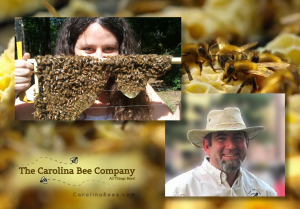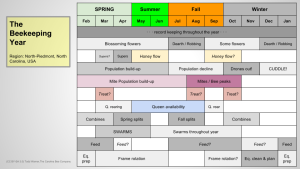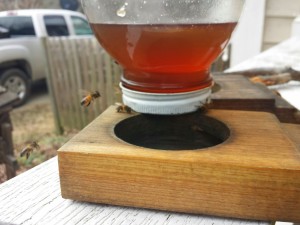
Guest post by Monica and Todd Warner
The outside world thinks that a farmer or beekeeper’s season starts when the flowers begin to bloom or the last frost passes. Where we live, that last frost date is right around tax day in mid-April, but really a beekeeper’s “Spring” begins when that first flower blossoms (early to mid-February for us). It is not uncommon for someone to walk up to us and make the statement, “Well, you guys have nothing to do until Spring, right?” Yup. Nothin’ to do…Ha!
The irony is that there are two ways to view the winter months as a beekeeper (and this is true for other farmers as well): what one should be doing, and what one actually is doing. “Winter Management” is a common topic for some of our talks. In that talk, we discuss at length all the tasks that one needs to tackle from October to February. And then, at the end, we usually have a confessional about all the things we didn’t do ourselves.
So, lazy beekeeper, you are in good company.
First of all, you may notice that the beekeeping year doesn’t line up with how the typical civilian separates the seasons. Bees operate on a different schedule. We are all affected by the change of seasons, but we all have different triggers for what is important to us.
So, what should you be doing now, but aren’t? The best advice we have ever received came from an ol’ timer beekeeper (Bill Waddell of My Daddy’s Honey). His advice “You’ve got to keep ahead of your bees!” sounds simple and sounds like it applies to just about anything if you take out the bit about honey bees. But that is what makes it so powerful a message. It is really that simple (deceptively simple). Those bees will not wait for you. Much like a pregnancy, that baby is coming! The baby will not wait, and your honey bees will not wait. You can be reactionary or proactive. With honey bees, how much honey that is generated, and how healthy those bees are throughout the year, boils down to how well they start off that year.
“You’ve got to keep ahead of your bees!”
-Bill Waddell
Do your bees need supplemental feed?
Right now, as we write this, it is the beginning of March. Throughout the winter, we should have been monitoring the honey bees and ensuring they had adequate food. In January, we should have assessed our coming needs for the year and mapped out a plan for equipment needs and what our goals are. January and February are equipment months, or should have been. Repairs take time. Frames can take an awful lot of time. Do you plan to expand in the coming year? If you do, did you order honey bees?

Are your frames overdue for repair and cleanup?
Think about it by doing a bit of algebra. If you wanted to go from 2 hives to 4 hives, and you are using 10-frame Langstroth hive equipment… that means you have to purchase, assemble and paint 2 bottom boards, 2 tops, 4 brood chambers and 4 – 6 additional honey supers (let’s be optimistic while we are at it). That also means you need to assemble a total of at least 80 – 100 frames. That’s a lot of frames. The labor needed to assemble frames only becomes a much larger problem as you expand the number of hives under management, especially if you also replace wax every year.
You rotate your wax, right? More on that another time.
So, view this article as a kick in the behind (and yes, we are including ourselves in this). You know you need to get ready and Spring has already effectively sprung. We all got an extended winter this year, but that doesn’t mean that we received a bunch of free prep time, get off your duff and…
- check your bees when you can, and feed if need be
- take inventory of the equipment you have
- get your new equipment ready
- replace and repair equipment
- check that your stored equipment is in decent shape and not invaded by mold or wax moths
- seriously think about replacing your oldest brood comb and plan for that
- plan hive movements (moving a small hive is MUCH easier than moving a large hive)
That’s a good list to start with. Once you start getting organized, other ideas will pop up. Just make sure you make achievable goals and don’t fret if you don’t get to everything. But get out there! As wise old Bill Waddell says, “You’ve got to keep ahead of your bees!”
Good luck out there! Now, work on catching up so that you to can get “ahead of your bees!”
About the authors:
Monica and Todd Warner own and operate The Carolina Bee Company, a small family-run beekeeping business located in the North Carolina Piedmont (specifically, Vance County). As a couple they’ve been charming honey bees for over 10 years. They dabble in just about “All Things Bees” to include what one would expect of a beekeeper — honey, a bit of pollination, and breeding bees — but they focus predominantly on a sundry of traditional chandlery products (candles, bath and body products/soaps, lotions, etc.) which can be purchased from a number of stores throughout NC. They are also very involved in the regional agricultural community and often teach and write. More about them can be found at their website and all the typical social media services (Google+, Facebook, Twitter).












5 Comments
What about bait hives? They should be up weeks before swarm season, all locations scouted, and approved by the land owner.
Good morning, Tony and I are new to Bee keeping waiting on BEE’s now. I have to many people telling me where to place my BEE’s. I’d like to also make pee gravel area for them to sit on we live in South MS our late winter and Spring are our wettest season. We are starting with 3 hives live on 160 acres of pristine never been lived on before land lots of fresh water bottom land hard woods pines native flowers and we grow organic food would like to put in more flowers in the vegetable garden.
It is too bad they don’t have this type of schedule worked out for each state. NC has a far different schedule than what could be used up here in northern WI. Maybe someone could work on this to be able to print it out for club members.
Unfortunately this rookie was not aware of how much or when to add food to our first Bee Hive. Going into winter I thought they had plenty of honey to hold over during our coldest winter in recent history. Unfortunately I opened our hive mid march and all of our bees were laying dead at the bottom of the hive. and the comb was completely empty.
If at first you don’t succeed.
Waiting for our next set of bees due to arrive the end of April. Should the old hive be completely cleaned of the existing comb or will the new bees use it to get a head start?
Thanks
For latest information you have to go to see web and on the web I found this website as a finest
web site for most recent updates.